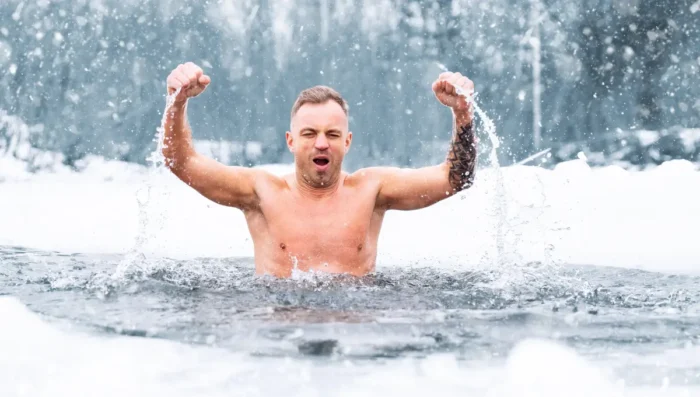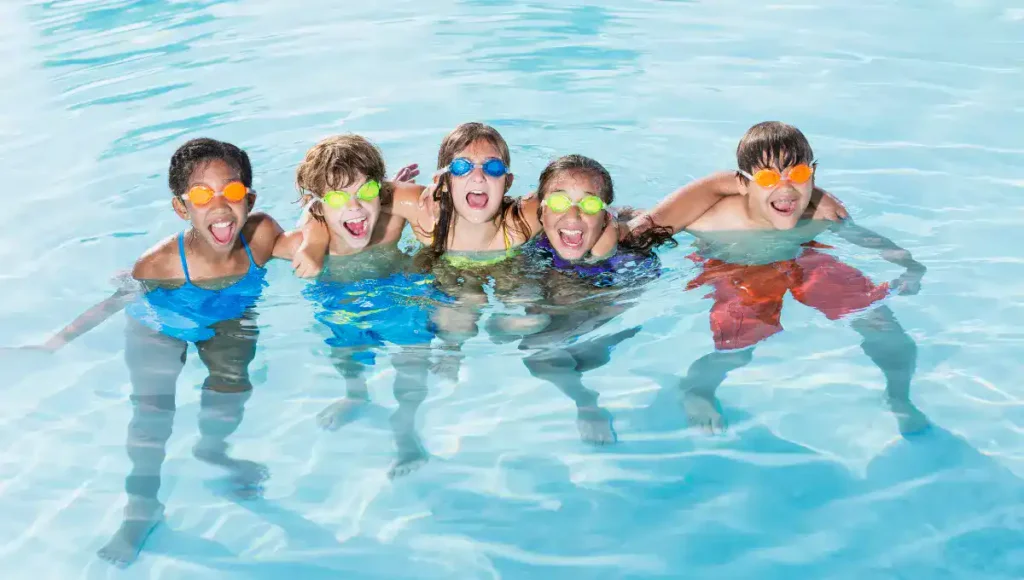Why Swim In Cold Water? Swimming in cold water boosts circulation, enhances immunity, and provides a refreshing and invigorating experience for both body and mind.
Embracing the chill of cold water while swimming can be invigorating, but it requires a unique set of skills and precautions.
In this comprehensive guide, we will explore essential tips for swimming in cold water, ensuring that you make the most of your aquatic experiences without compromising safety.
- 🤔 What Are The Benefits Of Cold Water Swimming?
- 📃 8 Tips for Swimming in Cold Water
- 🙋🏻♀️ FAQs For Swimming in Cold Water
- Q. Is it OK to swim in cold water?
- Q. How long is it safe to swim in cold water?
- Q. What happens if you swim in too cold water?
- Q. Is cold water swimming good for heart?
- Q. How can I make cold water swimming easier?
- Q. How do I get better at cold water?
- Q. Is swimming in cold water good for you?
- Q. How do I get over my fear of cold water swimming?
- Which is the best tip, in your opinion, for swimming in cold water? Tell us in the comments.
🤔 What Are The Benefits Of Cold Water Swimming?
The following are a few health advantages of swimming in frigid water:
- Mental Wellness: Cold water swimming lowers tension and promotes relaxation, improving mood.
- Calorie Burning: Swimming in cold water increases pulse rate, making the heart work harder and burning more calories compared to warm water.
- Improved Circulation: Cold water forces blood to the skin’s surface, enhancing circulation and warmth.
- Strengthened Defense System: Cold water swimming boosts white blood cell count, strengthening the body’s defense system over time.
- Physical and Mental Strength: Cold water exposure induces cold water shock, improving the body’s ability to handle stress and strengthening both body and mind.
- Increased Desire: Cold water enhances testosterone and estrogen production, positively impacting libido, fertility, mood, confidence, and romantic connection.
- Social Interaction: Joining an outdoor swimming group fosters social interaction and provides a shared experience with like-minded individuals.
Check expert’s suggestions for Cold Water Swimming—Benefits and Risks: A Narrative Review
📃 8 Tips for Swimming in Cold Water
Have you been inspired to discover your next swim or dip after reading about the advantages of cold-water swimming?
Read our beginner advice for cold water swimmers before you go; it will give you the confidence to enter the water securely.
1. Take cold showers
- Cold Showers for Training: Switching from hot to cold showers regularly is an easy way for cold-water athletes to start their training. It helps the body adapt to colder temperatures over time.
- Gradual Adaptation for Beginners: For those new to outdoor swimming, starting with cold showers is a beginner-friendly method to acclimate to the cold water. This gradual approach makes the adjustment more manageable.
- Avoiding Cold Water Shock: Entering very cold water can initially induce hyperventilation, leading to panic. Familiarizing yourself with this reaction is crucial in situations where composure is essential.
- Acclimating for Calmness: Getting used to colder temperatures through regular exposure helps your body acclimate. This gradual process reduces the initial panic associated with cold water shock, allowing for a calmer experience over time.
2. Choose the right clothing
- Wetsuit for Flexibility: A neoprene wetsuit shields your torso from the cold while providing flexibility for bathing. Ensure it’s flexible enough for comfort.
- Seasonal Gear Variation: Choose different gear for winter swimming compared to summer surfing. Adapt to the changing needs of the season.
- Body Temperature Stability: Opt for clothing with 4 to 6 centimeters of thickness to maintain a stable body temperature in cold water.
- Safety Essentials: For frigid water safety, wear a colorful silicone swim cap for visibility. Consider a swim tow float for added safety in case of cramps, often available in bright colors.
- Enhanced Vision with Goggles: Wear goggles for better underwater vision, avoiding panic in natural water bodies where visibility matters.
- Protection for Hands and Feet: Use neoprene gloves, booties, or wetsuit socks to protect hands and feet from the initial shock and potential bumps while entering or leaving the water.
- Post-Swim Changing Poncho: After swimming, use an absorbent changing poncho like the Vivida Poncho Towel Robes for easy neoprene removal and quick drying, ensuring a warm recovery after the chilly plunge.
3. Always warm up beforehand
- Pre-Swim Warm-Up: Before taking the plunge, spend a few moments on dry ground warming up, resisting the allure of the cold water.
- Running for Core Temperature: Engage in a short run before entering the cold water. This boosts your core temperature, raises your heart rate, and readies your body for the shock of immersion. It also promotes muscular relaxation, enhancing flexibility during swimming.
- Quick Exercises for Warmth: You don’t need an extensive workout. A few burpees or star leaps can suffice to raise your body temperature. This is particularly useful in chilly weather when shedding warm layers may not be comfortable.
4. Do a review of your surroundings
- Observing Surroundings: While warming up with a jog or stroll, pay attention to your surroundings. Use this time for a mini-risk assessment, considering potential emergencies and your response.
- Entering and Leaving Safely: Evaluate the approach to entering and leaving the ocean. Watch for uneven or slippery areas and plan accordingly. Identify a safe spot for your phone, ensuring it stays dry and accessible in case of need. Check for the presence of a lifeguard.
- Weather and Water Conditions: Assess the current conditions. If waves seem unusually choppy or there’s been poor weather, reconsider swimming. Lakes may be less clear, and rivers more turbulent than usual. Stay informed about conditions with apps like WILD, providing tides, weather, and feedback from fellow swimmers.
5. Don’t push yourself too hard
- Understanding Boundaries: When learning to swim in cold water, know your limits. While the urge may be to maximize time in the water, starting with short sessions is crucial for gradual adaptation.
- Gradual Progression: Begin with brief swims, even just a few minutes. Allow your body to acclimate to the cold before extending swim durations. Aim for at least one weekly session.
- Energy Expenditure: Open-water swimming requires more energy for both swimming and staying warm. Be aware that fatigue can set in quickly, so manage your energy levels.
- Recognizing Warning Signs: If you feel exhausted, drained, or achy, it could indicate moderate hypothermia. Exit the water promptly and warm up. Severe trembling also warrants immediate warming with non-sweet options like hot water or herbal tea. Layer up with warm clothing and keep moving to generate heat.
6. Don’t swim alone
- Enjoyable Social Aspect: Cold water swimming offers an unexpectedly enjoyable social activity. For many, the sense of community is a powerful antidote to melancholy, providing opportunities to connect with new and old friends.
- Safety in Numbers: Swimming with a buddy or group enhances safety. Monitoring each other’s progress, paddling together, and checking in before and after the swim contribute to a safer experience.
- Group Dynamics: Socializing becomes an integral part of the swimming experience for some. The camaraderie enhances the overall mood and energy. After the swim, warm up with a hot beverage, share insights on entry and exit points, and debrief for a fulfilling experience.
7. Keep close to the shore
- Stay Close to the Shore: For those new to cold water swimming or not yet confident in their limits, it’s advisable to stay near the land. This ensures a safe exit in case of cramps, excessive cold, fatigue, or sudden weather changes.
- Safety Precautions: Sticking close to the shore provides a quick and secure way to leave the water if needed. This is especially crucial in winter when weather conditions can shift rapidly, requiring swimmers to cut short their swim for safety.
- Weather Awareness: Given the unpredictability of winter weather, even experienced swimmers should exercise caution. Strong swimming abilities are essential to handle unexpected changes, but it’s wiser to avoid getting caught in adverse weather conditions whenever possible.
8. Get dressed in warm clothes and put on a changing robe
- Avoid Immediate Hot Shower: Post-cold water swim, resist the urge for a hot shower right away as it can lead to a sudden drop in blood pressure due to the rapid opening of blood arteries.
- Dry Off and Dress Warm: Opt for drying off and wearing warm clothing instead. Consume something hot and stay active to return to normal body temperature.
- Invest in a Changing Robe: A high-quality changing robe is a quick way to warm up. Change swiftly and comfortably, using the robe, which also doubles as a cozy jacket after your chilly swim.
🙋🏻♀️ FAQs For Swimming in Cold Water
Many questions arise when considering swimming in cold water; some of the most often-asked ones are addressed here.
Q. Is it OK to swim in cold water?
A. Swimming in cold water is generally safe; however, it’s crucial to acclimate gradually, especially for individuals with health concerns, ensuring an enjoyable and risk-free experience.
Q. How long is it safe to swim in cold water?
A. The duration of safe cold-water swimming varies among individuals. Listen to your body; if you feel excessively cold or fatigued, exit the water promptly to maintain safety.
Q. What happens if you swim in too cold water?
A. Swimming in excessively cold water may lead to hypothermia, causing symptoms like shivering, confusion, and numbness. It’s crucial to exit the water, warm up, and seek medical attention if necessary.
Q. Is cold water swimming good for heart?
A. Swimming in excessively cold water may lead to hypothermia, causing symptoms like shivering, confusion, and numbness. It’s crucial to exit the water, warm up, and seek medical attention if necessary.
Q. How can I make cold water swimming easier?
A. Ease into cold water swimming by acclimating gradually, investing in insulating swimwear, and practicing controlled breathing techniques for a more comfortable experience.
Q. How do I get better at cold water?
A. Improve cold-water swimming skills by focusing on controlled breathing, regular body movement, and knowing your limits, allowing for a more enjoyable and resilient experience over time.
Q. Is swimming in cold water good for you?
A. Yes, swimming in cold water offers health benefits, including improved cardiovascular health, heightened metabolism, and enhanced mental well-being, making it a beneficial and invigorating activity.
Q. How do I get over my fear of cold water swimming?
A. Overcome the fear by gradually exposing yourself, practicing controlled breathing, and celebrating small achievements, fostering confidence, and transforming cold-water swimming into an enjoyable experience.
Which is the best tip, in your opinion, for swimming in cold water? Tell us in the comments.
Also, don’t forget to check other articles on World Sports Gear. Enhance your knowledge about swimming and other related sports.



